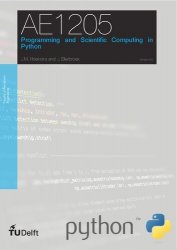 Название: Programming and Scientific Computing in Python
Название: Programming and Scientific Computing in PythonАвтор: J.M. Hoekstra, J. Ellerbroek
Издательство: TUDelft
Год: 2022 (v.6.0)
Страниц: 222
Язык: английский
Формат: pdf (true)
Размер: 10.2 MB
The first version of this reader was developed for, and during the pilot of, the Programming course in the first year of the BSc program Aerospace Engineering at the Delft University of Technology in 2012. Originally it was written for Python 2 and then converted to Python 3. The goal of the Python programming course is to enable the student to:
• write a program for scientific computing
• develop models
• analyse behaviour of the models, for instance using plots
• visualise models by animating graphics
A practical advantage of Python is that it supports many platforms (Windows, Apple, Linux) and that it is free, and so are all add-ons. Many add-ons have been developed by the large (academic) Python community. Some have become standards of their own, such as the scientific package NumPy/SciPy/Matplotlib. These scientific libraries (or modules as they are called in Python), in syntax(grammar) heavily inspired by the software package MATLAB, are now the standard libraries for scientific computing in Python. IEEE has named Python as the de facto standard programming language for data analysis.
The course assumes some mathematical skills, but no programming experience whatsoever. This document is provided as a reference for the elaboration of the assignments. The reader is encouraged to read through the relevant chapters applicable to a particular problem. For later reference, many tables, as well as some appendices with quick reference guides, have been included. These encompass the most often used functions and methods. For a complete overview, there is the excellent documentation as provided with Python in the IDLE Help menu, as well as the downloadable and on-line documentation for the Python modules NumPy, SciPy, Matplotlib and Pygame.
Also, the set-up of the present course is to show the appeal of programming. Having this powerful tool at hand allows the reader to use the computer as a ‘mathematical slave’. And by making models, one basically has the universe in a sandbox at one’s disposal: Any complex problem can be programmed and displayed, from molecular behaviour to the motion in a complex gravity field in space. An important ingredient at the beginning of the course is the ability to solve mathematical puzzles and numerical problems. Also the very easy to use graphics module Pygame module has been included in this reader. This allows, next to the simulation of a physical problem, a real-time visualization and some control (mouse and keyboard) for the user, which also adds some fun for the beginning and struggling programmer in the form of visual feedback.
Next to the mathematical puzzles, challenges (like Project Euler and the Python challenge) and simulations and games, there is a programming contest included in the last module of the course for which there is a prize for the winners. Often students surprise me with their skills and creativity in such a contest by submitting impressive simulations and games.
Скачать Programming and Scientific Computing in Python